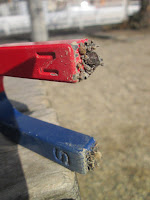Let’s make a soap bubble with your kids.
1. Firstly, let’s make the liquid for the soap bubbles.
The recipe calls for 50 cc of hot water, 40 cc of liquid starch and 10 cc of
detergent for kitchen.
You should stir them.
2. Let’s make the soap bubbles at the park neighbor.
You can easily make it by using a straw, a small loop and something with
multiple holes.


Hope you and your kids enjoy the playing.
















